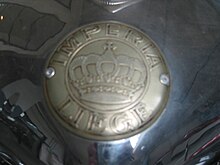Automobiles Imperia
Imperia was one of the most prestigious brands in Belgian automotive history and was founded in 1904 by Adrien Piedbœuf .
history
Adrien Piedbœuf had a construction workshop, first for motorcycles, then also for cars in the rue de Fragnée in Liège , but in 1907 he moved to the new factory in Nessonvaux built by Henri Pieper , a Liège arms manufacturer.
Located on the edge of the Liège – Verviers road, this building is an example of the architectural eclecticism of its time. Adrien Piedbœuf probably chose the name Imperia in memory of his stay in Aachen , where he had worked in the family's iron-processing factories. Originally three models were made. In 1910, an Imperia car reached 144 km / h on the Brooklands route in Great Britain .
In 1912 Imperia merged with the Springuel company from Huy . The factory in Nessonvaux now produces several hundred cars a year. After the First World War , production began again under the name Imperia-Abadal. The new owner Mathieu van Roggen realized that he had to step up production and make smaller, cheaper cars. In 1923 the 1100 model came out, which achieved several racing successes, and in 1927 a six-cylinder model with a displacement of 1.65 liters.
Faced with competition from foreign manufacturers, some of which were based in Belgium, Mathieu van Roggen decided to set up a consortium. In 1927 he bought Métallurgique from Marchienne-au-Pont and Excelsior from Zaventem , and in 1928 the manufacturer Nagant . In 1929 he acquired a stake in the French manufacturer Voisin .
Through the Great Depression 1929 Imperia got into trouble and produced from 1932 to Adler Trumpf under license.
In 1934 van Roggen took over the prestigious insolvent Antwerp brand Minerva , which built luxury cars that were expensive to manufacture. With the parts left over from the bankruptcy, Minervas were still made until 1938. In 1936, a prototype of a new Minerva of the top luxury class was built in Nessonvaux, a front-wheel drive car with 3.6 liters displacement and automatic transmission. The war ended this project, which would have produced one of the most modern cars of the interwar period.
From 1947 to 1948, Imperia built the TA-8, the last of its own models, under licenses from Adler , Hotchkiss and Amilcar . The basis was the Adler Trumpf Junior and a joint prototype from Hotchkiss and Amilcar with 1340 cm³ from 1940. There was also a sports version. After that, standard Vanguard models were assembled and sold as Imperia. After Standard decided to set up its own factory in Belgium, Automobiles Imperia was out of work and had to close in 1957.
Beginning again in 2008
In 2008, the Belgian company Green Propulsion bought the naming rights to launch a hybrid vehicle under the Imperia brand .
In July 2012 the Imperia GP was presented, a hybrid vehicle with a retro look that should have the consumption of a Smart and the performance of a sports car (4 s from 0 to 100 km / h). The market launch was announced for mid-March 2013, but was postponed later. In April 2016, Automobiles Imperia filed for bankruptcy.
literature
- ASBL DAMAS, L'épopée de l'usine Impéria à Nessonvaux , Cercle de recherches historiques Damas de Fraipont-Nessonvaux, 1998
- ASBL DAMAS, Les belles Nessonvautoises , Cercle de recherches historiques Damas de Fraipont-Nessonvaux, 2004
- David Burgess Wise, The New Illustrated Encyclopedia of the Automobile
Web links
- Company history (French)
- Website with pictures
- Lost Marques: Imperia - Sticking With The Side Valve Engine A Decade Too Long , Unique Cars and Parts USA (English)




